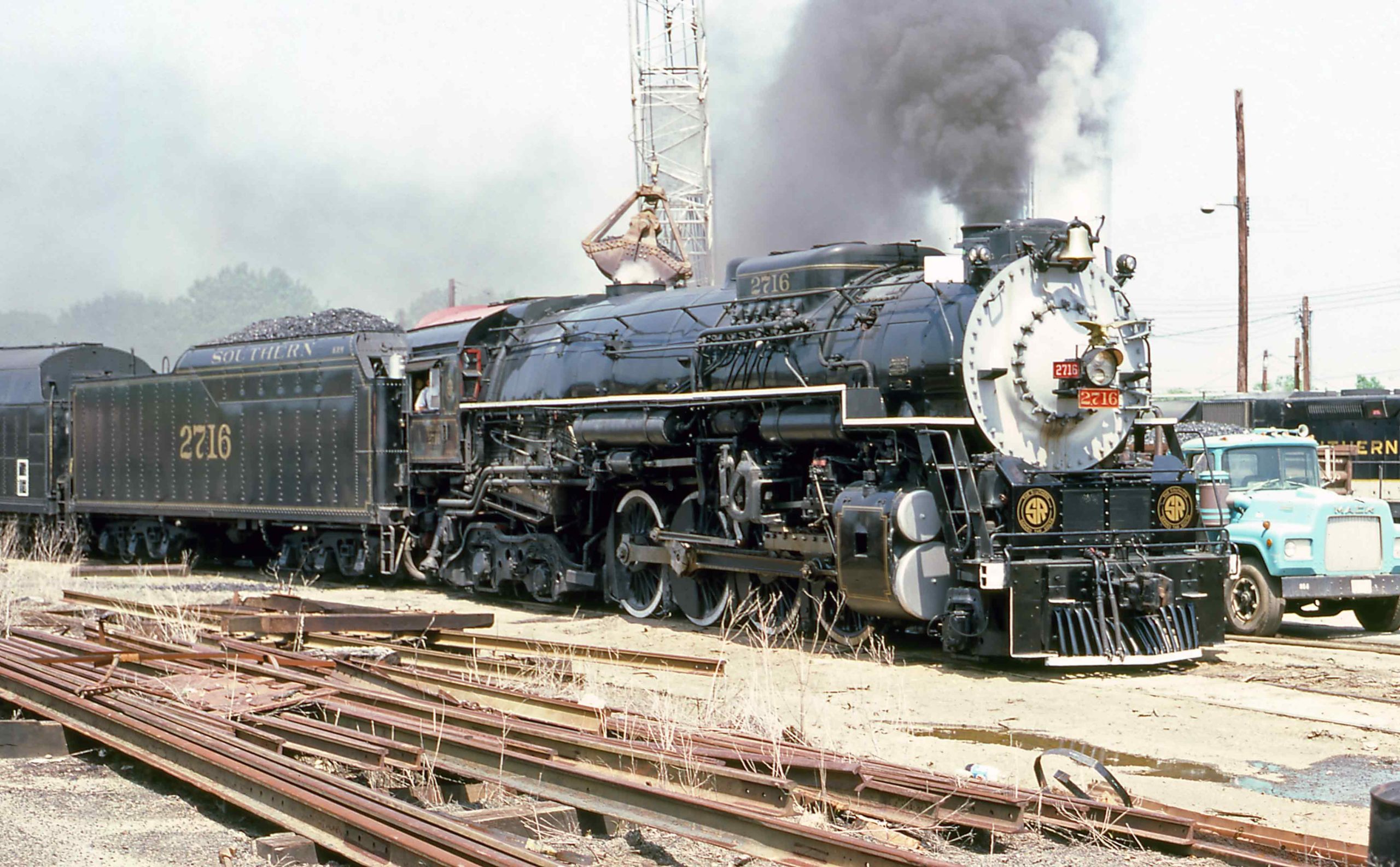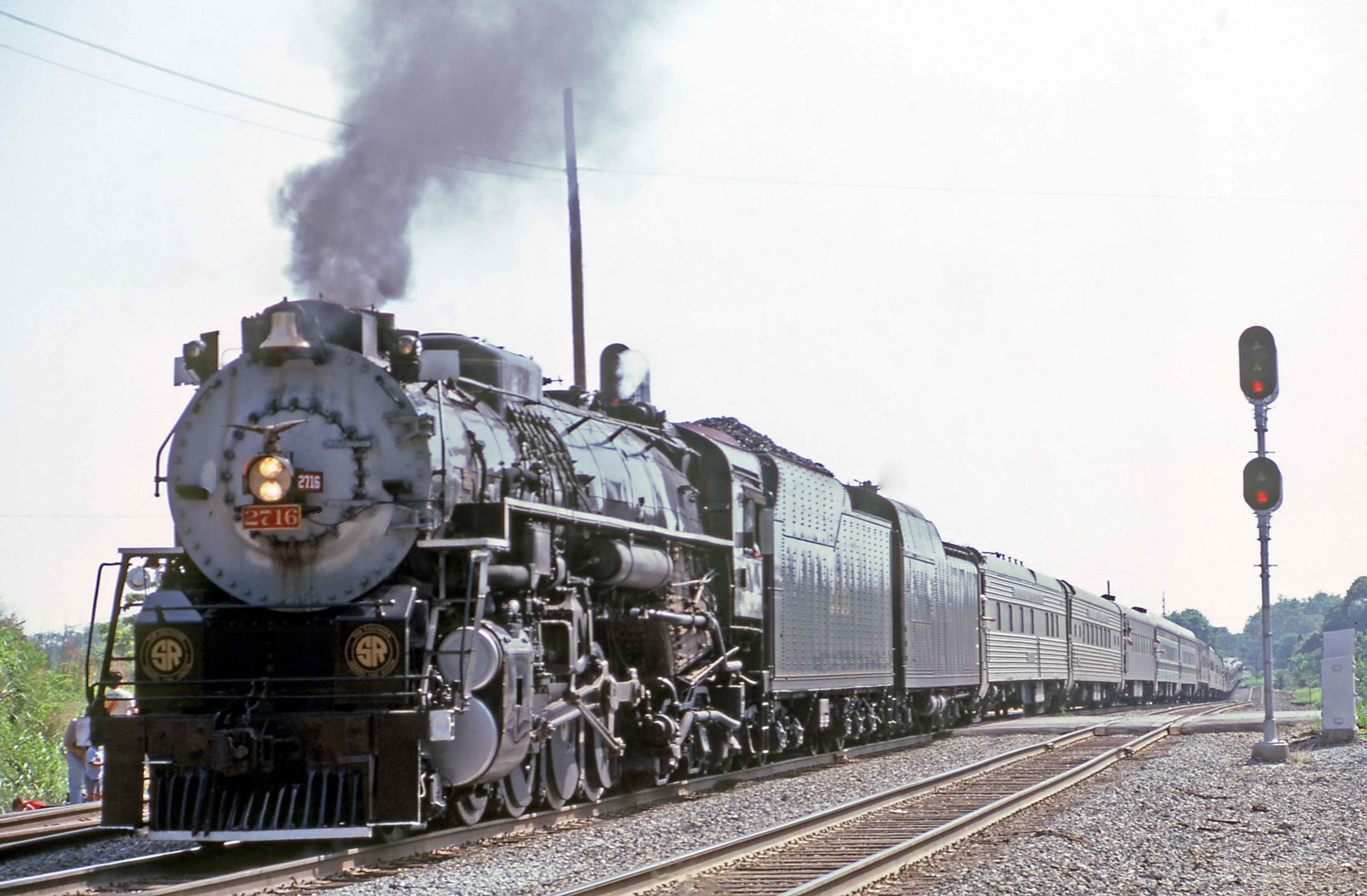The Kentucky Steam Heritage Corp.’s announcement this morning coincides with the calendar date, 2-7-16, and comes almost 20 years after the big Kanawha-type locomotive last operated in the 1990s. The locomotive is owned by the Kentucky Railway Museum and has been restored to operation on two different occasions: once by the Southern Railway in the 1980s and once by the Fort Wayne Railroad Historical Society in 1996.
This week, the group signed a long-term lease for the locomotive. Group members expect to move the engine to the Lexington area later this year. Chris Campbell, president and founder of the Kentucky steam group, tells Trains News Wire that the group hopes to have the engine steamed up by 2020. The restoration is expected to cost between $800,000 and $1.3 million.
No. 2716 was one of 90 Kanawhas purchased by the C&O between 1943 and 1947 for use in both freight and passenger service. Today, a dozen of the locomotives remain but only No. 2716 has ever run in the preservation era, albeit on two separate but brief occasions. When the locomotive was first restored by the Southern in 1982, it was given a makeover to look more like that road’s own locomotives, even though the Southern never had 2-8-4s. The C&O veteran was among the first “Superpower” locomotives used in the Southern’s steam program and Campbell says that is one of the reasons why the group selected it for restoration.
“The locomotive’s roots run abnormally wide through the region,” he says. “It’s a C&O locomotive but it also has ties to the Southern Railway and even though it was only part of their steam program for a few months it left its mark.”
Another reason the locomotive is an attractive candidate for operation is that it has been restored on two different occasions in the last 35 years but has rarely run. However, since the locomotive last ran, the Federal Railroad Administration’s rules for steam locomotives have changed, meaning the No. 2716 will need a full and complete 15-year overhaul before it can be fired up. The restoration is being headed up by Jason Sobczynski, who has been involved numerous other steam restorations, including the current effort to preserve and operate Reading Company 4-8-4 No. 2100. In November 2015, Sobczynski and others from the Kentucky steam group did a complete inspection of No. 2716 and found it to be in sound condition. While rumors have spread in recent years that the locomotive’s firebox is condemned, officials say ultrasonic readings on the interior of it show that while parts will need to be replaced, a vast majority of it is still in excellent condition.
“Most aspects of No. 2716 are in better condition than many of today’s operating locomotives,” Sobczynski says.
The locomotive will be restored at a yet-to-be determined facility in the Lexington area. Campbell says it’s important to the group to locate the project there not only because of the C&O’s ties to the town but because they hope to involve the local community, not just rail enthusiasts and steam fans.
“This project will help Lexington reach back to its industrial roots,” he says.
Although the group has not spoken publicly about where they hope to operate the locomotive, Campbell says they have already talked to some short lines that are open to hosting the locomotive. He also says they are optimistic the locomotive will be able to run on a main line in the future.
The locomotive is being restored in conjunction with the Kentucky Railway Museum, which also owns Louisville and Nashville 4-6-2 No. 152. Board member Rob Minton says the museum is working closely with the Kentucky steam group and that they’ve been impressed with the non-profit’s enthusiasm and ability.
More information is available from the Kentucky Steam Heritage Corp.’s website.
















I love that they’re showing her in her Southern livery. Southern or C&O, this is a beautiful locomotive. And a special “Thank You” to Mr. Schultz for helping set the record straight. Stuff happens! Acknowledge it and work together to fix it instead of wasting energy pointing fingers!
Whenever Owosso holds another event, they would probably invite 2716 and 765 for what I would call a Berkday. They would do like a triple header!
Matching rolling stock and rails to run on? Absolutely. Use the Friends Of The 261 in operation in Minneapolis as a template. They have put together complete matching trainsets and run on BNSF, CP and TC&W trackage. It can be done and it is beautiful when it happens.
Huge! Great news!
There are a lot of restored passenger cars in the U.S. and even more waiting to be restored. I agree that the "circus train" look is a little silly behind a beautifully restored locomotive, but there are reasons for that. A lot of historic groups (the ones that restore passenger cars) won't have anything to do with painting a car anything other than EXACTLY what it wore in December of 1938 or whenever it was new.
Personally i'd rather see complete trains – like when they put together a "daylight" back in the 80's. I'd argue that train was responsible for a whole new generation of rail fans, myself included. Most people probably didn't care about the Frisco dining car that was painted in the "wrong" colors to make that effect possible. So long as we don't start putting paint on stainless cars, I say go for it.
Biggest killer for many of the restored engines is good trackage for them to stretch their legs out. With patchwork rail line ownership and management that does not want them and high insurance restrictions they are limited as to where they can go.
I am in shock at the nerve of some people… I amongst so many others have long believed the rumors of 2716's "irreversible disrepair". It has long been stated with supposed confidence that this particular locomotive would "NEVER, EVER" run again, because the damage done to the firebox by Bill Purdie's crew in 1982 was too extensive. Bull… People need to get their facts straight before they begin passing off any type of information to others as true "without a doubt". I am glad that I personally put the rumors regarding Norfolk and Western 1218 to rest when I had a private conversation with Scott Lindsay at the NCTM when he was leading the restoration of N&W 611 in 2014. He basically told me that what many people have spread around is total garbage and lies. 1218's internal parts ARE NOT "permanently misplaced" or "gone forever"!!! Some are being stored in a safe location which cannot be publicly disclosed, and the other missing pieces are in the tender right behind the engine itself! If you take a peak back there when you visit the VMT, you will know what Scott means. Anyway, I hope this group is very successful in this project, and that the third time IS a charm for this wonderful locomotive. I remember seeing 2716 for the first time in the National Geographic documentary "Love Those Trains", and boy, what a beauty in Southern livery! What a sound as well! That whistle they put on her was so eerie and haunting, it reminds me of Frisco 1522's whistle.
I think what's really needed would be sets of passenger cars for them to pull. A heavyweight train and a lightweight train all painted similarly. The UK has this and it's so much better than the circus trains pulled by most excursion engines. Why can't there be a group(s) that can do something like this?
So many old steam engines being restored, but they need somewhere to run.
we need preserved passenger cars, to be used with these efforts. Unfortunately, we have lost several RDC's in Canada that could be used as non powered coaches. .